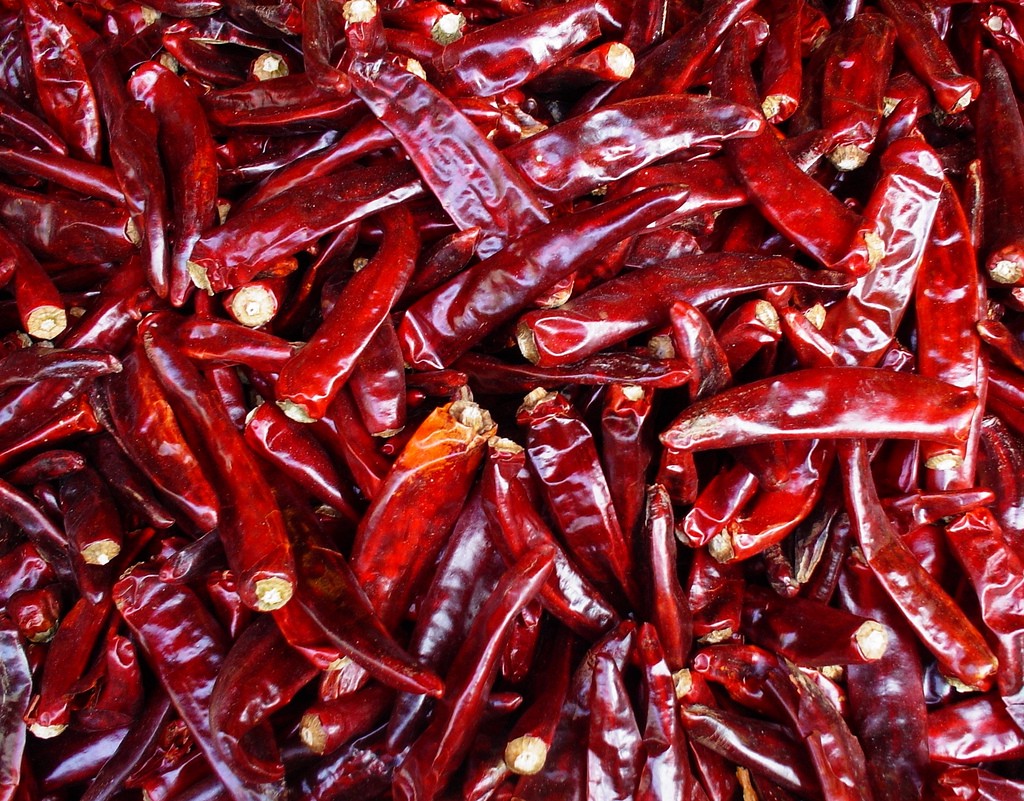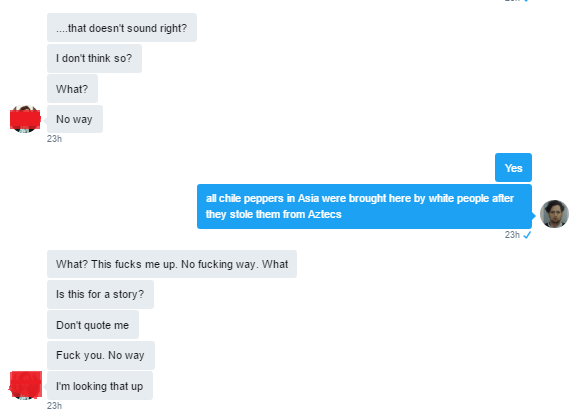All Spicy Food Is From Latin America
Deep globalization is real.

If you ever go to Asia (do not do this, it is too big, and trying to comprehend it will only convince you that your mind was never meant to really comprehend anything) and you want to put all the attention rightly back on yourself, the important American, here is a little trick you can use. First, be in one of the countries that makes really spicy food, and then performatively eat stupid amounts of it in front of everyone. Hurt yourself badly, but pretend like you do this all the time. Probably, everyone will laugh and someone will say, “Whoa! Usually Western people don’t like chilis.”
This is your chance. Lean forward, sweating like a giant asshole, wink, and say, “Actually, all spicy food is from the West. Chilis come from Central and South America, and they were brought over here after Spanish colonization. None of your chilis are native to Asia.”
People will probably want to fight you. Because obviously, this is what is called a huge “dick move” in every language on Earth. I personally have a bit of Mexican heritage, and a small chip on my shoulder about the fact that the agricultural and civilizational achievements of Pre-Columbian Meso-America are insufficiently recognized (in 1492, the Aztec capital of Tenochtitlan was larger than any European city, until Spaniards destroyed it).
That said, many Indonesians, or Malaysians, etc., do know the botanical history of the capsicum, just like some Texans know that conquistadores actually brought over their “longhorns” and many Italians know that pasta is probably originally Arab (not Chinese, like in that Marco Polo story, which is fake) and that their famous red sauces often lean pretty hard on the Central American tomatl, (one of a few words from Nahuatl that actually traveled into Western European society, instead of the other way around).
But for people in India or Thailand who don’t know that all spicy food is from the Americas, it can be pretty jarring. Here’s a conversation I just had with a well-educated, multilingual Indonesian.

Actually, I lied a little bit. All chilis in Asia were brought over here by white people after they stole them from not just the Aztecs, but also the Incas, and many other native American peoples. I don’t blame her! It feels fucking weird. They’ve been a part of local cuisine for centuries. They grow everywhere. They are part of local identity. They are nature.

She got really mad at me, and I understand why. There is a lot about deep globalization and its effects that is so counterintuitive that it’s hard to process easily. We have been changing the world in strange ways for a long time. But humans have stupid primate brains, and we tend to naturalize whatever is right in front of us.
The world looks flat. Actually, the floor of the world, a creation of our senses, is indeed flat, it’s just the actual physical Earth that is technically curved. So yes, it was pretty messed up what they did to Galileo, but I get it. If some know-it-all came up to me in the 1600s and said, “well, Actually, no, the Earth is spinning around the Sun,” I would want to fuck him up too. I’d think, there’s just no way that is true, and either way, this guy is being a huge dick.
But, the chili thing is true. Everything that is spicy is a member of the capsicum genus, which is native to the Americas. To the extent that things like wasabe, horseradish, or black pepper sometimes feel like they light you up in a similar way, it’s not because of capsaicin. Nothing but chilis register on the Scoville scale. The fruit of the capsicum is what we call the chili pepper, which might be quite hot, like a habanero, or very mild, like the bell pepper. Some are small, some are big, most are bright and beautiful. They have undergone plenty of changes since 1492, both intentional and accidental. But, those chilis weren’t just hanging “naturally” in the North American Garden of Eden. Native Americans had cultivated them for thousands of years.
The fact that, when talking of the capsicum family, we say that chili “peppers” are “spicy,” means we are committing a double linguistic anachronism (which is fine). It was of course “spices” that all those Spanish and Portuguese were looking for (especially black pepper) in Indonesia in the first place. And since chilis kinda make your mouth pop in the same way as black pepper, they got named “peppers,” and we call them “spicy,” though the biology and sensation produced are actually totally different. The word “Chili” itself is Nahuatl.
Consider again how stupid humans are. These Iberian adventurers cast out across the world, on very shitty boats, because they wanted some of this little powder that makes your mouth tingle a bit at dinner. They went around the world, destroying civilizations and starting new ones, because their meals back home were boring without it.
In a few hundred years, we may look back at our own times, and think it was just as insane that we privileged deregulated financial capitalism and #branding over all other possible versions of globalization, remaking the world in the image of Coldplay and Uber rather than, say, universalizing democracy or labor rights.
500 years after our round of globalization has ended, it may be possible to think that strip mall parking lots and KFC are literally part of nature. Or that you might get punched in the face if you say that English is Actually from a country that used to be called England, not the official language of the United Amero Zone (the UAZ, pronounced “WAZ”).

I recently moved from Brazil to Indonesia for work, and I recently got hit hard by a moment of deep globalization. Both countries are big (Brazil has world’s 5th-biggest population, Indonesia is #4) and “developing,” but other than that my move was fairly random, dictated by a few personal connections and the vagaries of the journalism market.
So imagine my surprise when I started learning Bahasa Indonesia, the Malay dialect picked to be the national language here not too many decades ago. It’s an Austronesian tongue with essentially no grammar, and no family relation even to mainland Asia, let alone to Indo-European languages. But something happened as I learned a number of really basic words, all the kind of thing you’d learn in a high school Spanish chapter entitled “Around The House.”
cepatu = shoe
meja = table
jandela = window
kameja = shirt
bangku = bench / chair
Those words are just Portuguese, with like maybe one letter changed. Of course, of course, I looked it up and it turns out there’s a lot more words that were adopted into Malay as the Portuguese were active around here, starting in the 1500s. Indonesians do know about this linguistic history. But I had a really hard time taking it in. I checked with lots of Brazilians, and they all thought it was insane, too. This is not like when you hear Portuguese in Mozambique or Angola or East Timor — that’s normal. That’s modern colonialism, that was recent full nation-state domination. These are huge living artifacts, plain as day, left by men just trading nearby, hundreds of years before the US was founded.
Something weirder was happening here, too. These kind of loanwords usually enter a language because there’s no local concept for them. Shit, does this mean that shoes, tables, and shirts are inventions? Well of course they are, fuck, fuck. Ok, fine, that seems fairly benign compared to some of the other effects of various globalizations. But out of all the globalizations that have ever happened and ever will happen, perhaps the spread of the chili is the best one, because chilis are amazing.
A year or so ago on the USA internet, there was a set of pretty hilarious jokes about how white people eat food with no flavor. Even more hilariously, some white people got mad and thought it was racist. Between men and women, preferences for spicy food are as hilarious as you’d expect. One study suggests that women actually like the taste more, while men are often more into the way they think it makes them look cool. Especially in front of women.
But globally speaking, it’s not really your ethnicity or your gender that determines how spicy you eat, but where you’re from. In Mexico and Northeastern Brazil, white people (yes, they exist) eat loads of spicy food. Down in colder, whiter, Southern South America, mayonnaise is about the spiciest thing most people eat. In Chile, Argentina, or Uruguay, an entire meal might be a breaded steak (no seasoning) and some potato salad, or just french fries topped with cheese, deli ham and — if you’re lucky — a pinch of oregano.
There are a few theories as to why certain societies started really earnestly using chilis. One is that they act as a relatively effective antimicrobial, which could help safety and preservation, especially in hot climates. Another is that it’s pleasant to feel warmer, and then sweat a bit, especially in hot climates. This has something in common with the practice of drinking hot tea in places like India, but there is a difference — hot water really does increase your body temperature, whereas spicy food only tricks your body into thinking it’s burning. Another theory is that the euphoria that comes after the initial (harmless) pain is pretty fun. And one more is that it results from a simple lack of food. Eating spicy makes it feel like you ate more, and it makes it easier to choke down bland starches. This is why some people diet using loads of hot sauce. Anthony Reid thinks that Southeast Asia first got really wild about chili when the Japanese globalized into, I mean, invaded the region during WWII and food became scarce.
But I have my own theory why societies don’t stop eating chilis once they start. It’s because it’s nice to feel more things and taste more tastes along with your food, and once you realize nothing bad ever happens, it’s a quick and easy upgrade. It also means that you can ingest ancient magic Aztec energy, which is real, every day forever.
